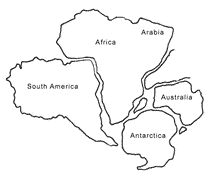|
|
|
|
The continent and its islands There are various theories about the geographic location of this super-continent; however, most geologists agree on estimates that its land mass has always been located in the southern hemisphere and that for around 200 million years, it was clumped around the pole before withdrawing more to the north. To get an idea of the origins of Gondwana, all you have to do is look at a map of the world and pull together the edges of the continents. Surely the western coastline of Africa fits in with its South American counterpart opposite? And doesn't the configuration of the south coast of Australia curiously resemble the edges of Antarctica across from it ?
Proof that Antarctica once belonged to the super-continent of Gondwana, comes from geological probes that have unearthed the existence of identical rocks of the same age and fossils common to both: in Enderby Land for example, we find granite and glacial sediment similar to what is scattered along the east coast of India. There are also the ranges of mountains that go from one continent to the other, enabling us to reconstitute the entire ranges; hence we find the extension of the transantarctic range along the eastern part of Australia, and formations from western Antarctica (Ellsworth mountains) in South Africa and South America. Other proof comes in the form of the fossilised bones of the land Lystrosaurus (an animal that looked like a short-legged dog, with just two canine located along each side of the upper jaw, which lived on Earth about 200 million years ago) and fossilised traces of the conifer Glossopteris - an aquatic plant reaching ten metres in height - have been found on all of the continents created by Gondwana, including Antarctica. Other elements back up the geological proof: in 1982, the Americans discovered that the ancestors of the Australian marsupials did not come from North America, as was believed until then, but from Antarctica. In December 1985, some very old aquatic plants and remains of fossilised wood were found in the transantarctic mountains, proof that the continent's climate has not always been polar. The final parameter providing the proof that Antarctica was once part of Gondwana is to do with bathymetric readings. If, instead of taking the contours of the geographic coastlines as the edges of the continents, we based ourselves more on the geographic extent of the continental plateaux, the various forms created would show that Africa, Antarctica, South America, Australia and India all occupy the same relative mutual positions. Take two coastlines that appear to fit together in terms of being reconstituted; the continental plateau of both will plunge into the abyss at the same depth and their level curves under the seas will be practically identical. It has also been proved that although both the eastern and western parts of Antarctica come from Gondwana, they do not have the same geological features and so would not have taken the same route. Which is how the hypothesis came about stating that the land forming the base of eastern Antarctica used to be the heart of the super-continent and became positioned close to the South Pole, while Gondwana moved imperceptibly around the Earth's globe; for its part, western Antarctica came about through the slow reconstruction of a giant jigsaw puzzle made up of pieces of differing ages that were put in place independently and at separate times. |

 160 million years ago, the super-continent broke up. An initial dislocation saw Africa and South America go their separate ways. Then it was the turn of Australia and New Zealand, which were formed 60 million years ago, while Antarctica, abandoned and alone, slowly migrated to its present position while breaking away from South America 25 or 30 million years later. From this period onwards, the great ocean currents developed, encircling the continent; the formation of the Drake Passage between the southern end of South America and the tip of the Antarctic peninsula when the two continents finally separated (around 25 million years ago) was to speed up the process of isolating Antarctica and giving it its current climatological genes.
160 million years ago, the super-continent broke up. An initial dislocation saw Africa and South America go their separate ways. Then it was the turn of Australia and New Zealand, which were formed 60 million years ago, while Antarctica, abandoned and alone, slowly migrated to its present position while breaking away from South America 25 or 30 million years later. From this period onwards, the great ocean currents developed, encircling the continent; the formation of the Drake Passage between the southern end of South America and the tip of the Antarctic peninsula when the two continents finally separated (around 25 million years ago) was to speed up the process of isolating Antarctica and giving it its current climatological genes.